|
A moment of 1/72 scale P-38
madness
Five Lightning Strikes
in Eight Weeks
by Mark Davies
|
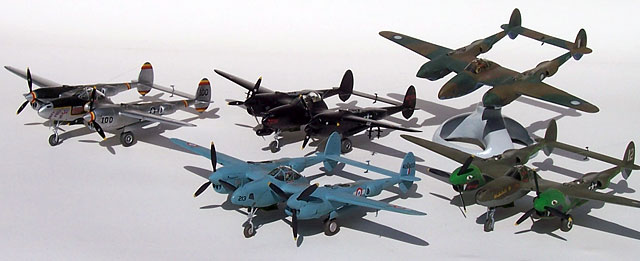 |
|
P-38 Lightning Collection in 1/72 scale |

HyperScale is proudly supported by
Squadron
My modelling club, IPMS Auckland (New Zealand), decided to run a
“Build the Same Kit in 2 Months” competition. The Tamiya P-47 and
Trumpeter Ferdinand were chosen as the 1:48 aircraft and 1:72 armour
subjects respectively, and the new Academy P-38 was the 1:72 scale
aircraft choice. The deal was that all finished entries would receive a
$10.00 kit voucher, and the winner would be reimbursed the cost of their
kit. As I only build the one true scale I put my hand up for a P-38 and
Ferdinand.
Having got my Academy P-38 I soon realised that my Airfix, Hasegawa and
Dragon P-38 kits had been thoroughly eclipsed in terms of modernity, and
it seemed in quality too. Thoughts of selling my “babies” for bargain
prices were briefly reviewed and promptly rejected for the following
reasons:
-
I’d never built the Airfix kit, even
in the 1960’s when it was released, yet it offers the only
reasonably accurate source of an F or H airframe (The Hasegawa H
option doesn’t get around the later style boom radiators which are
too large for an H).
-
My Dragon kit was of the two seat
P-38M night fighter. Like most Dragon kits, I expected it would fit
where it touched, and touch where it fitted, but detail was
reasonable and it was after all an impressive looking beast.
-
The Hasegawa kit showed its age in
terms of design, but for all that looked simple to build and offered
the usual fundamental Hasegawa quality. Besides which, it offered
parts for both the P-38 H and J/L. I could use Hasegawa’s superior H
intercooler intakes (Lower front cowl parts) on my Airfix kit, plus
replace the Airfix canopy which seemed too small compared to
Hasegawa’s and Academy’s.
Following this appreciation process my thoughts returned to what to
do with the Academy kit if I was going to build something a bit
different form the box offering of a Pacific Theatre P-38J. I’d just
read a review of Contact Resine’s F-5B reconnaissance nose conversion
(plus a set of wheels), and a mate had decals for a USAAF F-5 I could
use, so I ordered one from an internet stockist and started the kit.
My Contact Resine nose arrived and I soon found that it was too narrow
for the Academy kit! I’d delayed my build and wasn’t in a good frame of
mind, especially when I found that it was about the right width for the
Dragon kit. Anyway, I have to confess to sending a not very pleasant and
accusatory email late at night to roMarc Guerrero of Contact Resine
about my concerns. I was shamed by the very pleasant reply I got from
Marc Guerrero and the offer to send me a free replacement ASAP from
France. I accepted this offer and shortly after received a more
expensive edition of the F-5 nose and wheels that included decals for
some French machines. This nose was a fraction wider than the first
which must have suffered from shrinkage, and fitted fine to the Academy
kit. I can’t speak highly enough of Contact Resine’s response and a
series of very helpful emails. In recognition of this I chose to build
an overall Haze Blue French F-5B (although not the one of those covered
by the Contact Resine decals).
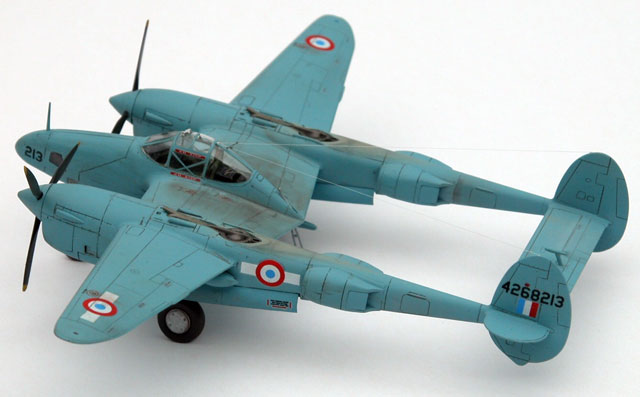
My plans were almost complete, when I thought that it was a pity not
to be using the Academy kit for a natural metal machine as it was likely
to go together with the minium of fit problems. The solution? Buy
another one and build two. Then I realised that once I built the two
Academy kits I’d never resort to building the other three older P-38
kits I had, so obviously I’d have to build them all at once! Foolishly I
though of the time I’d save production-lining fives of everything like
cockpit interiors, wheel-wells and props etc. So now I had five P-38’s
and one Ferdinand to build in two months and I was three weeks into the
project.
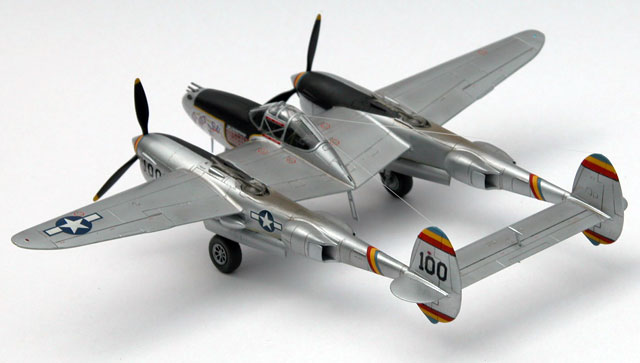
Having decided on this mad course of action I did a final review of
my plans concerning schemes and versions. I’d build the two Academy kits
as a haze blue French F-5 and a natural metal P-38L using my Hasegawa
kit’s “Putt Putt Maru” decals. The Dragon p-38M would be a black
night-fighter using kit decals, and the Hasegawa kit would be an olive
drab over neutral grey P-38J with bright green dragons down the booms
using some Aeromaster decals donated by a friend. The problem was that
the Airfix kit would also need to be an olive drab machine too if I was
to use the decals I had available. Then I remembered the spare and
slightly skinny Contact Resine F-5 recon nose I had. I could build an
RAAF F-4 with green, dark earth and azure blue camouflage which was a
scheme I’d always liked.
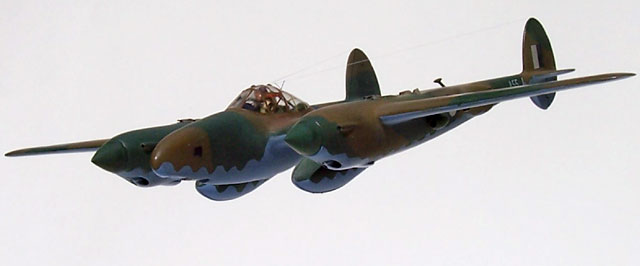
To save time, (yeah right!), I build the F-4 wheels up and do my
first flying model, plus it would save room in the display cabinet by
flying over my wheels-down models.
So to get on with recounting the construction of the five kits,
here’s a quick summary of each build and accompanying photos of the
finished products:
Academy Conversion - French F-5
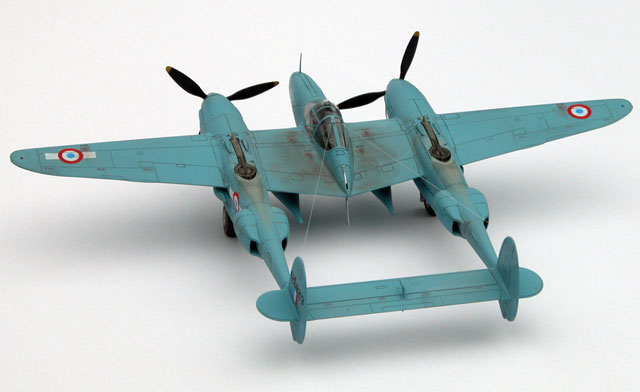
Saw off the kit nose and replace with Contact Resine nose.
Scratch-build some cameras and glaze with clear plastic sheet, replace
the seat with a resin one and add radio wires to the boxes behind the
pilot’s seat. Overcome the front cowl fit problem (a bit oversize), and
slightly enlarge the radiator cowl openings, plus thin the wing trailing
edges. Remove undercarriage door hinges to make doors sit at correct
angle, and shorten the front door retraction jack for the same reason.
Next time remember cutting out the slot for the retractable step is
easier before assembling the kit!
Academy P-38L
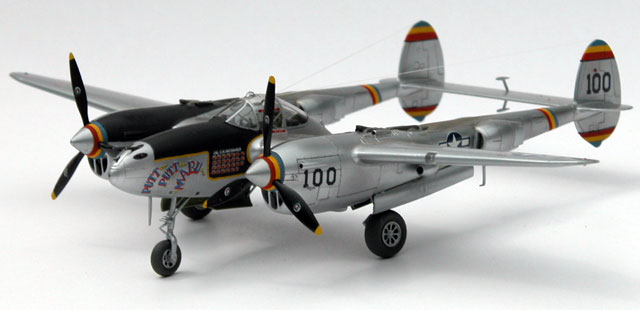
Build out the box with the same modifications as the F-5 build, other
than the nose of course. Add wing lights and other changes like the gun
camera stores pylon (donated from the Dragon kit) to make a P-38 J from
an L. Go through two sets of dreadful old Hasegawa kit decals, and
had-paint the yellow trim lines, plus mask and spray the tail fin and
spinner stripes after failing with the kit decals (in part because the
Hasegawa spinners have a different taper to Academy’s).
Hasegawa P-38J
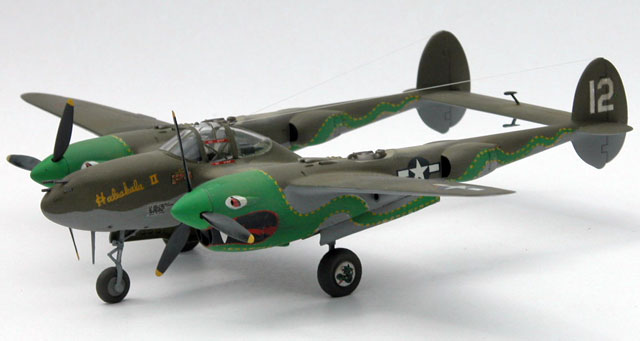
Replace seat and add radio wires etc, add radiator inserts to avoid a
see-through effect on the tail-booms. Use the kit’s P-38 F canopy as the
P-38J I was building had this early style canopy. Paint and apply
decals. Start over again because the Aeromaster decals are some of the
worst I’ve ever used (they were thick, inflexible and wouldn’t react to
decal softener). Having painted the final colours spray the booms green,
cut templates from the decal instructions and mask out the dragons,
re-spray the olive drab and neutral grey. Make own brew of decal
softener from Acetic Acid Glacial (a benefit of working for a lab
suppliers wholesaler), and add the yellow dashed outlines to the dragons
having trimmed the carrier film as much as a I can and using my decal
softener. Touch up with hand painting as necessary. Add Academy bombs.
Airfix Conversion – F-4
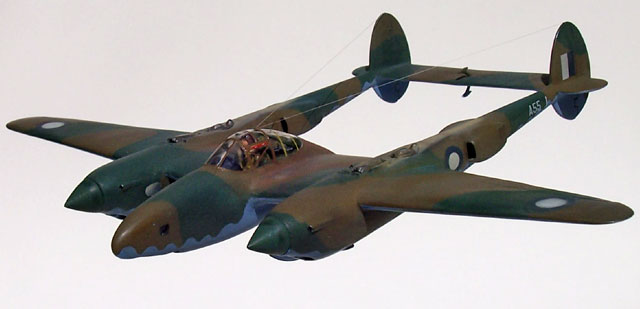
Fill Contact Resine F-5B nose camera ports, and Dremmel out new F-4
ports. Saw off the nose and replace with modified Contact Resine nose.
Dremmel away the rear cockpit coaming to fit the spare Hasegawa P-38J
canopy (after sanding off the front canopy framing and reshaping to
P-38E shape as the F-4 was based on a P-38E). Add radiator inserts to
avoid a see-through effect on the tail-booms. Then add the early-style
control wheel and a pilot from the spares box. Saw off the lower cowls
and replace with those from the P-38 H parts left over from Hasegawa
kit. Use heaps of filler and sand the rivets off. Add an underwing
landing light having filled in the leading-edge light. Use the Hasegawa
drop tanks as the Airfix pylons are for a P-38L with the gun camera
fitted.
Dragon P-38M
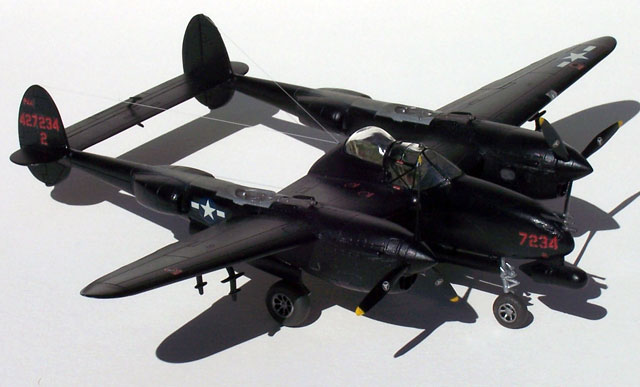
Struggle with atrocious fit and dreadfully complex design of centre
fuselage and wings, booms and outer wing panels. Add radiator inserts to
avoid a see-through effect on the tail-booms. Replace nose cone with
Academy part left over from the F-5 conversion to build a “bit of meat”
into the skinny Dragon nose. Add seat belts and heaps of filler, plus
Academy fuel tanks. Paint in a hurry and be surprised to find I quite
like it! Also decide that the brief idea of buying another Academy kit
to convert to a P-38M using the Dragon centre fuselage wouldn’t have
been worth the trouble after all! Although given time, a kit-bash of the
Dragon P-38M and Academy P-38J would result in a better night fighter
model for competition purposes.
And the Trumpeter Ferdinand? This very complex kit was being built in
the background on and off when I needed a break from the P-38’s. I fair
bit of work had gone into overcoming the fit problems of the track links
when I dropped it about three days before the deadline. Some rack links
flew off and disappeared in carpet and it now awaits another day to be
finished.
Having built the five kits I can make the some general comments about
them. Academy need to learn to mould wing trailing edges with the top
wing for a thinner trailing edge. The Hasegawa kit was significantly
superior in this respect. Academy and Dragon both have awkward
undercarriage doors that don’t sit right unless modified at the hinges.
Airfix managed to mix some P-38 H, J and L features into the one
airframe, but all in all it still the basis of a nice model, although I
feel their canopy is too small. Dragon’s kit is over-engineered and very
hard to build with everything in proper alignment as there is no
one-piece upper-wing to brace and brace everything. I was amazed at the
different interpretations of things like overall kit parts breakdown,
cockpit coaming interpretation, taper of spinners, and sit on the
undercarriage (my Hasegawa P-38J really needs the sit corrected to more
of a squat on the rear wheels). Suffice to say, kit-bashing around the
Academy kit will give the best results for all versions, although I’m
happy enough with what can be achieved with the Hasegawa and Dragon
products. For a really nice P-38 F or H you could take an Academy P-38J,
use Hasegawa’s P-38 H intercooler cowls and canopy, plus sacrifice an
Airfix kit for its boom radiators (wish I’d thought of this before).
Finally, I’ve concluded that production-lining only works if you’re
building the same brand kit. I may has well been building five different
aircraft makes for all the good it did me on this occasion. Would I
build another P-38? Definitely one day; but not for a decade or so at
least!
Click
the thumbnails below to view larger images:
Images and Text Copyright ©
2005 by Mark Davies
Page Created 15 May, 2005
Last Updated
15 May, 2005
Back to
HyperScale Main Page |
Home
| What's New |
Features |
Gallery |
Reviews |
Reference |
Forum |
Search